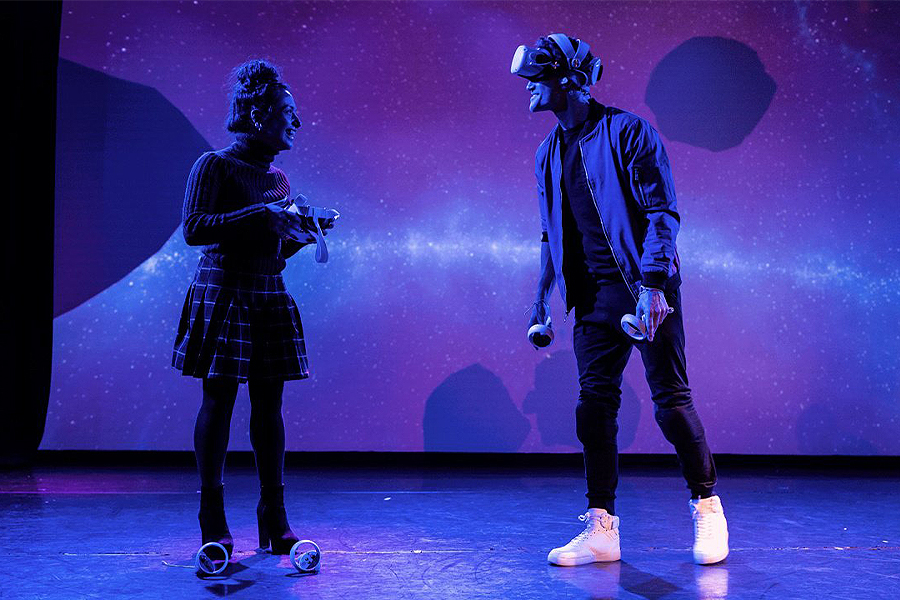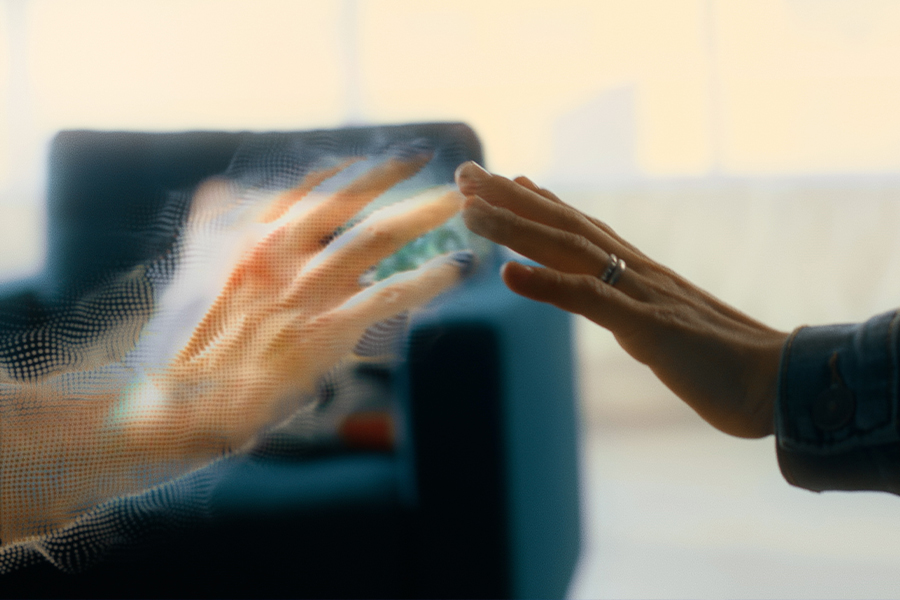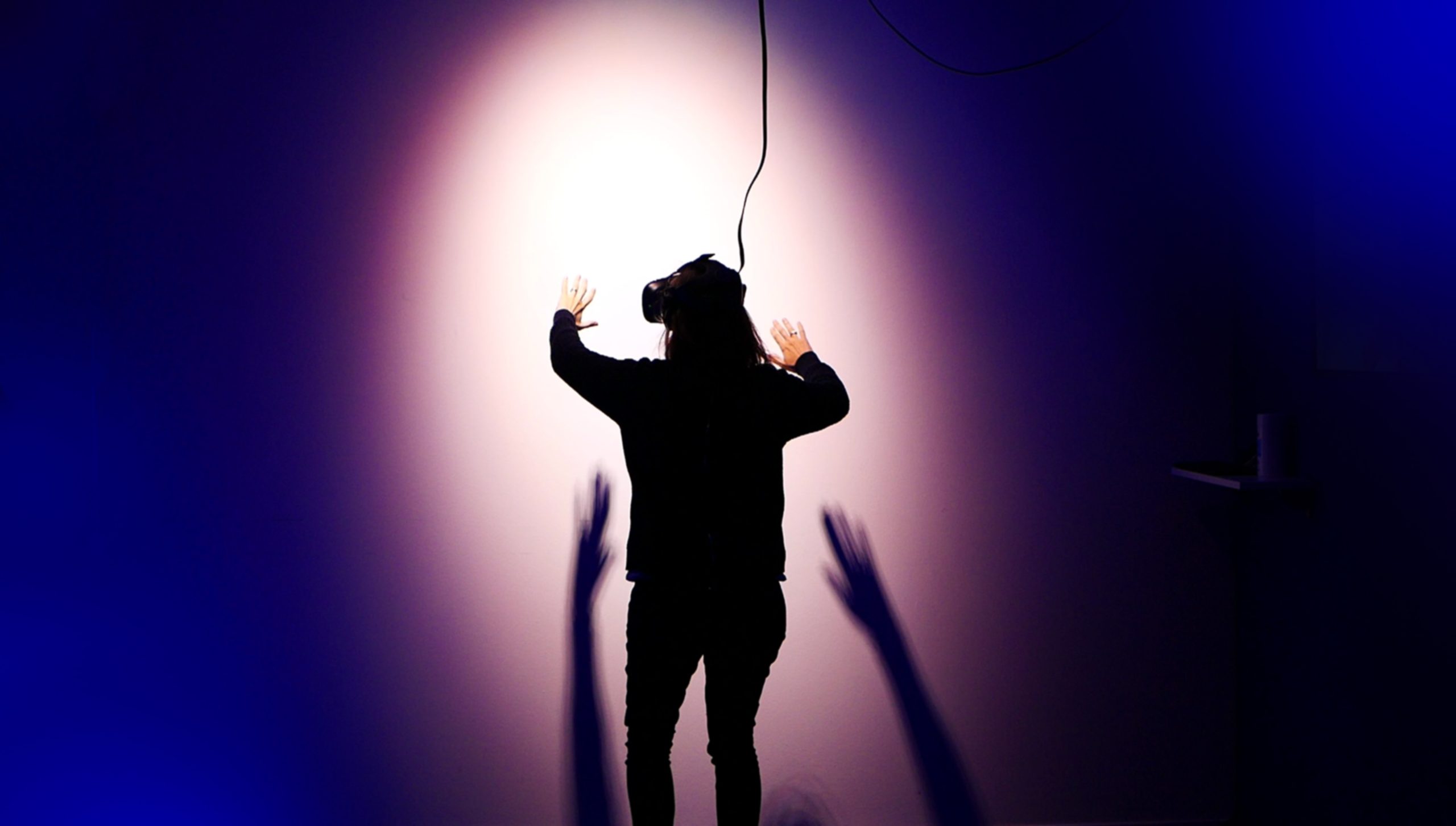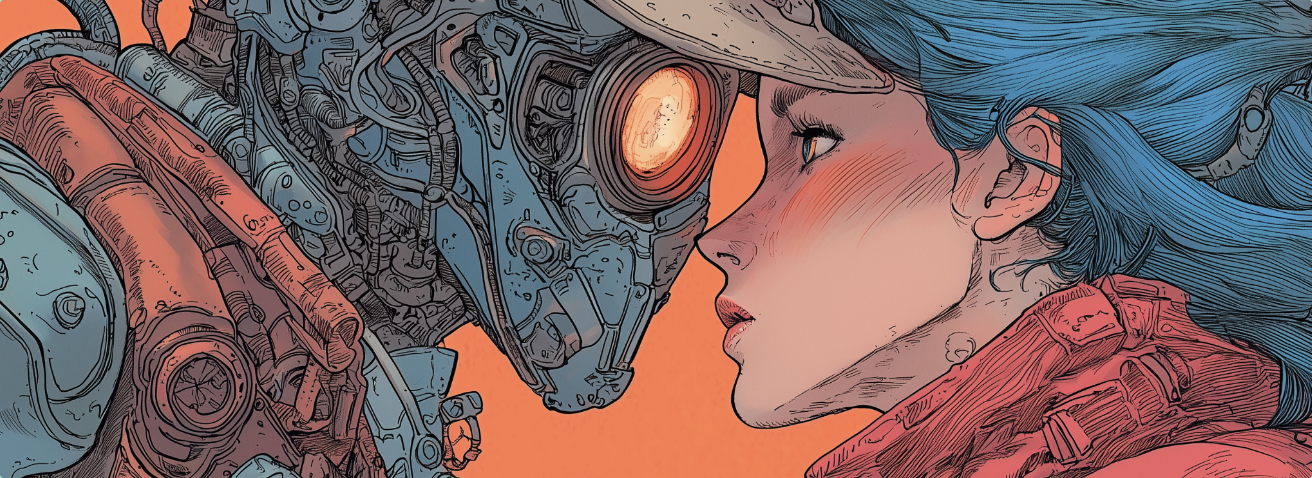If you’ve ever tried an at-home VR experience, chances are that you’ve ended up feeling a bit… disappointed.
The potential of VR – fancy, sparkly headsets! A fully immersive world, from the comfort of your sofa! – is massive. But to date, a lack of investment in the technology and a struggle to get people on board has meant that we’re some way from realising this potential. Combined with the argument that VR is an inherently isolating medium – immersing you so fully in a virtual world that you’re cut off from your environment and fellow humans – and the idea of it as a revolutionary medium for connection might seem a little odd.
However, as with any emerging technology, there are pioneers already out there pushing the boundaries of what it can achieve and laying the groundwork for future experimentation. One such pioneer is Whitton Frank: producer and performer at Ferryman Collective, who bring live, immersive narratives to life in virtual reality for people and with performers from all over the world.
Frank believes that one of VR’s greatest assets is that it gives people the ability to truly connect with each other in a meaningful way that feels “real and wonderful”. Participants experience the beauty and wonder of the virtual world with intimacy, connection and emotional resonance, in an experience they can all share by helping, talking and being a little vulnerable. What emerges is an experience that combines the best parts of film, theatre, video games, and VR.
In this Campfire she reveals the challenges and triumphs of this new storytelling medium, and how you might borrow its powers to create greater connection and vulnerability in your own experiences.
Read on to discover:
- The success and potential of combining live performances with scripted narratives in virtual reality, demonstrating its prowess as a storytelling medium.
- The ability of virtual reality to connect performers and audiences from around the world, enabling shared moments and connections in a virtual space.
- The three key elements to create intimacy and connection in virtual reality experiences: the power of gesture, the power of immersion, and the power of shared experiences.
- The importance of intimacy and connection in the virtual environment and the necessity of incorporating human connection as a fundamental aspect of VR technology.
- VR’s potential to offer unique and immersive experiences by combining the best elements of video games, film, television, and the virtual space for a truly captivating audience experience.
The Origins Of A Revolutionary New Art Form
Frank sees Ferryman Collective’s role as creating a new style of theatrical entertainment: a digital Broadway. Each performance uses live actors behind VR avatars interacting with audience members in immersive, intimate settings. And while their largest audience to date has been about 10 people, these performances are scalable as they can happen multiple times.
The seeds of this work were planted in 2013, when Frank and her co-founder Deidre Lyons met while working on a video game created with Oculus and Meta Quest called The Under Presents. The brief was to include live actors to puppet some of the characters, leading to some surprising revelations:
- It created a whole community of fans who were entranced by the notion that a character was truly coming to life to talk with them, and that they could have their own unique story and connection with his character.
- Fans made whole storylines with our characters, despite the fact that in this particular game, the players couldn’t talk. Everything was gesture and movement.
- Different forms of communication were created just for this game. Players could conjure objects, and they would use those objects to self identify.
Ferryman Collective was inspired in the wake of this experience, spurred on by the movement and excitement around the concept of live interaction in a virtual space and how the connections, friendships and stories that were formed were so meaningful to people.
VR As A Broader Form Of Storytelling
When we combine live performance with VR technology, our world expands, not contracts. Frank outlines three ways in which VR can expand our creative horizons:
- Scope. In this brave new world, performers can transport audiences to any location or setting without ever leaving the virtual space, all from the comfort of their own homes. As Frank says, “Live performance has been a crucial part of human entertainment and experience for centuries. We hope to continue to add to that tradition, as well as make it more accessible.”
- Accessibility. Live performance in virtual reality has the potential to make the arts more accessible than ever before. No longer limited by physical location or capacity, virtual reality performances can reach a global audience connecting people from all corners of the world. It also gives power to the actor to engage with people from a comfortable space.
- Expression. Using specially designed headsets and controllers, audiences can immerse themselves in the performances, interacting with the performers and each other in real time, creating the opportunity for shared emotional experiences and connection. This type of work is creating new opportunities for artists to express themselves and create performances that would be impossible in the physical world using the infinite possibilities of virtual space. They can explore new forms of dance, theatre and music, pushing the boundaries of what was once considered possible.
The Challenges Of VR Storytelling

The work Ferryman Collective does is pioneering a new set of storytelling. This comes with its own set of challenges, as it is still an emerging medium fraught with technical hurdles and a steep learning curve.
- Challenge: after about 10-12 people participating, the latency in voices gets a bit distracting. This limits the number of participants in one performance.
However: the technology is still scalable because there can be multiple performances, depending on how many actors you can involve. In Brendan Bradley’s Non-Player Character, he creates several layers of connection in a large-scale performance by having some people on stage in a headset, and others watching on and deciding narrative choices via an app. - Challenge: an hour is about as long as most people can comfortably manage in a VR headset. This limits the length of a performance, especially if you want to create one-on-one time with each participant.
However: this can also provide useful creative constraints that inform your storytelling. - Challenge: current mixed-reality performances that also use AR are often pre-recorded, which is generally much less engaging than a performance that has live elements.
- Challenge: VR relies on immersion predominantly through sight, and cannot play with senses like taste or smell that are proven to be memory-making.
However: there are shows, such as the immersive, multisensory experience Forager, that combine VR with other senses. Gestures can also be very powerful on their own.
Despite these challenges, the technology behind VR will continue to improve at an accelerated pace, making the possibilities for live performance and virtual reality limitless.
“The creative show will be grounded in the heart with a strong foundation of the human experience, so that when the element of awe-inspiring visuals is added, it gives the audience an experience that can only be found in the realms of this new emerging storytelling genre.”
Whitton Frank, Ferryman Collective
As Abraham Burickson outlined in our previous Campfire, experience design is an emergent function with everything to play for, as we define its future together.
The Three Superpowers Of VR Storytelling
Frank outlines three powers inherent to VR storytelling. How might you use them in your own experiences?
- The Power Of Gesture
Gesture is incredibly powerful in connecting people. A handshake, hug, or hand holding all have meaning in the real world. You’d think with no haptics that they would lose something, but they don’t. Seeing another human being gesture feels equally cathartic.
In Welcome To Respite, up to 10 people can participate, with one “hero member” taking the lead role of the protagonist Alex, a child suffering from dissociative identity disorder. The hero participant can choose the pronouns and skin tone of their avatar to increase a sense of connection. When playing Alex, people had powerful reactions to physical gestures like the mother character holding their face and telling them they loved them, including crying.
“Because it’s a trained actor behind the avatar, the connection and intensity is just as powerful as IRL, because in a way it is – but you have the benefit of people being in a safe space so they can let their walls drop and become fully immersed.”
Whitton Frank, Ferryman Collective
Even though it’s an avatar and there are no haptics or actual feelings, you still have gestures that can pull forth emotional responses from your audience and foster an environment of intimacy.
- The Power Of Immersion
VR gives you the ability to really create fully immersive worlds where participants have costumes that feel real, they feel embodied by their avatar, and the world is truly 360 and everywhere you look is immersive.
In Gumball Dreams, a psychedelic, transformational experience for 3 audience members and 1 actor, participants were called to a distant planet to help a creature named Onyx to die/pass on/transform. Ferryman Collective created a 360-degree world where you could run as far as you liked and never leave.
- The Power Of Shared Experiences
In Find WiiLii, 5 audience members are asked to make a choice whether to support a company that is collecting and selling on people’s memories, or tear it down from the inside. Participants have real agency, as their decision will impact which ending they experience, and everyone has to agree.
“We’ve had speeches, yelling matches, and everyone instantly agree. People really bond as a group. You have to have multiple audience members, as the idea is to connect people, especially if they can’t in real life.”
Whitton Frank, Ferryman Collective
Similarly in Gumball Dreams, audience members had to physically interact and work together to solve problems, as well as getting a one-to-one with the live actor. They form a bond with both the actor and each other.
Intimacy And Connection Are The Foundation Of VR Storytelling

Frank ends with an impassioned cry for the power of VR storytelling to create real connection, not separation or isolation.
“In the virtual environment, intimacy is incredibly important and connection is incredibly important. That’s what people want. That’s why they come to new technology. And I think that often gets forgotten. As people rush forward, they just see the tech part of it. They don’t see the human part. I will adamantly fight for the fact that human connection must be a part of the virtual space.”
If we really want people to adopt headsets, we have to think back to the beginnings of the internet: what really got people there was chat rooms and porn! Both are about seeking something from other humans. I believe that VR technology can be a tool for connection, as opposed to a means of separating people. We can give people these unique experiences, which in my mind combine the best of video games, film, television and the virtual space to create incredible, immersive pieces for humans.”
Whitton Frank, Ferryman Collective
Without writing, performance or storytelling, technology is just that: technology. It’s human creativity that brings it to life, and human connection that gives it meaning.
The WXO Take-Out

Whether you’re already using VR in your experiences or not, we think Frank’s work is an inspiring example of how we might take a piece of emerging technology and play with it to create a new form of storytelling that can stand on its own, but which can also give ideas to other people working in other spaces.
There’s an opportunity to consider how we play with the notion of identity in our experiences. In VR, we’re able to choose an avatar to play behind, which can bring us closer to others. Think of Peter Holst-Beck’s work on “identity” as one of the “i”s in the 7i experience strategy – or alternatively, of Jessica Creane’s work of building on the person’s existing identity.
Ultimately, knowing which technology to call on to achieve different outcomes is key to approaching new forms of tech. If you’re looking to connect a small group, VR could be really powerful. If you’re working with a larger group, more traditional live performance combined with elements of VR might be more effective.
So next time you’re designing an experience, ask yourself:
- How do you use the power of gesture in your experiences?
- How do you create 360-degree, immersive worlds?
- How do you make audience members feel connected – both to your actors, and to each other?
- How do you use technology to amplify the impact of your experience?
- What emerging technology might provide new ways for you to tell your story?
Want to come to live Campfires and join fellow expert experience creators from 39+ different countries as we lead the Experience Revolution forward? Find out more here.






